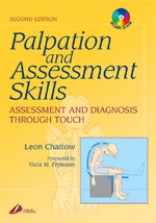|
|
|
| |
 |
|
|

|
 推薦指數:
推薦指數:





|
|
- 內容介紹
|
Palpation and Assessment Skills with CD Rom, 2nd Edition
Leon Chaitow , Private Practitioner, Senior Lecturer University of Westminster, London, UK
ISBN 0443072183 · Paperback · 384 Pages · 140 Illustrations
Churchill Livingstone · Forthcoming Title (June 2003)
Like the popular previous Edition, the new Edition of Palpation Skills has been designed and developed to help the reader to understand and acquire the palpatory skills which are the foundation of all effective manual therapy assessments and treatments. Subtle and sensitivity of touch and the accurate interpretation of palpatory tests are required from the start of training in any of the manual therapy professions. It is difficult to learn these from written descriptions or static illustrations alone. By combining a workbook approach with the use of video demonstrations and audio explanations on a CD-Rom, Palpation Skills provides the student and developing practitioner with a portable workshop which they can access at any time.
Palpation Skills: Assessment and Diagnosis through Touch will be of practical to use to every manual therapist and practitioner at all stages of their professional development. It can help them to extend the range of skills they can bring to their practice by bringing together suggested approaches from a variety of disciplines.
Features
Covers the palpation and assessment of all tissues and systems, including the skin, muscle structure, and the spine and pelvis
Gives practical guidance and instruction on a broad variety of palpation techniques
All the palpation techniques covered are clearly described and illustrated in the text and supported by video film on the CD-Rom
Each technique is supported by practical exercises and self assessment questions. Further questions relating to the video clips are included in the CD-Rom
Directs the beginner in the correct way to carry out the techniques and provides additional techniques for the practitioner to add to his basic library of skills
Provides outcome expectations against which progress can be measured. The video support can help to identify how to improve these skills.
Written by a highly respected practitioner and teacher - brings his workshops to the individual at home and in the clinic
2 colour printing throughout the text helps to clarify the structure of the content and the details of the movements being shown in the diagrams
The CD-Rom supports and supplements the written text.
What's New
2 colour printing throughout - making it an easier text to follow
CD-Rom now included - featuring video clips to expand the descriptions in the text
New section on assessment methods relating to particular regions - shoulder, hip etc.
More cross reference between palpation of different types of tissues and diffeent anatomical regions
More material aimed at the experienced practitioner - who wants to improve their interpretations of findings.
Contents
Foreword. Preface. Dedication. Glossary.
1: Using appropriate pressure (and the MPI).
2: Structure and function: are they inseparable? Palpatory accuracy - mirage or reality?
3: Visual assessment and the dominant eye. Fundamentals of palpation.
4: The morphology of reflex and acupuncture points. Palpating and assessing the skin.
5: Is it a muscle or a joint problem? Palpating for changes in muscle structure.
6: Red, white and black reaction. Palpation of subtle movements (including circulation of the CSF, energy, and 'has tissue a memory?).
7: Assessing dural restriction - Assessment of 'abnormal mechanical tension' in the nervous system.
8: Source of pain - is it reflex or local? Introduction to functional palpation.
9: Joint play, 'end-feel', range of motion: what are they? Palpation and assessment of joints (including spine and pelvis).
10: Percussion palpation - Visceral palpation and breathing function assessment.
11: Palpating the traditional Chinese pulses - Palpation without touch.
12: About hyperventilation - Palpation and emotional states.
Appendix. Index.
|
|
|

